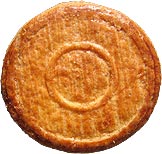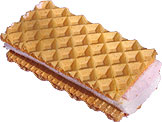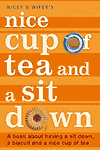Jules Destrooper Almond Thins | | Monday 8 Nov 2004 |

 | Sometimes its tricky to work out who is behind a Tesco's Finest own label product, other times its so blindingly obvious you have to wonder deeply why they even bother. So this week we are looking at a biscuit from Belgium, based on a family recipe going back to 1886. The self same biscuit can be purchased as Tesco's Finest Continental Almond Thins. Mind you the Jules Destrooper ones have the various name translated into Dutch, French and German, which are Amandelbrood, Pain aux Amandes and Mandelblätter. Normally trying to read German words just gives me a headache, but I think I like this one a lot.
The pack bears a crest telling us that they are purveyors to the Belgian Royal Family. Which at the least reminds me that when dreadful chap from the Daily Mirror was snooping around the Queen's breakfast table last year the very least he could have done was verify that all the stuff the Queen was eating was by appointment to her Majesty. Or indeed that her pantry was stacked full of all those royal appointment products. That would have been mildly related to journalism. At the risk of stereotyping the Belgians (but come on why should they be exempt from the broad and under-informed NCOTAASD brush, already applied to the Americans, French, Australians, Chinese and Scandinavians?), presumably the suppliers of beer, chips and chocolates are also well favoured by the Belgian Royal household. Given that we are inundated with news reports of Belgian citizens dying in their millions from this diet, we should be thinking about finding out what their secret is. They must be doing something to counteract this cardiac overload diet. Then again maybe they are dropping like flies and we just haven't taken any notice. What ever the truth, it seems that as a nation the Belgians have compensated for most of their country looking like the duller sections of the M11 motorway, by developing an essentially naughty cuisine. Good for them.
The ingredients are delightfully simple, wheat flour, brown sugar, butter, almonds and salt. Based on the evidence it seems likely that the biscuits are formed by taking thin slices off of a cold block of dough, prior to baking. This would explain the precision in the placement of the sliced almonds, and thier uniform thickness. Given the simplicity of the recipe one would expect an uncluttered taste, and that's what we get. Butter toffee sweetness, plays against roasted almonds, and the brittle biscuits can snap into unexpected triangular shards. A fairly porous underside means that dunking may be attempted, should you fancy it. The flavour is not a million miles away from nutty britle, (sheets of hard glassy toffee with embedded roasted peanuts that the sweet shop man used to smash into bits with a special toffee hammer.)
Obviously anything that comes in a plastic inner tray with an outer foil pouch and a fancy box is not going to be competing head on with custard creams. They are certainly worth a quick go and I'm sure you could wedge a couple in some nice ice cream to make a useful drop of pudding. I wonder if the Belgians have thought of that? Probably. Your feedback 1 message |
| Galettes Bretonnes | | Wednesday 27 Oct 2004 |
 | The other week Wifey and I mounted a carefully planned and executed mission to foreign soil, in order to secure vital supplies for the forth coming festive season. So whilst in France relieving the French of some of their wine, we took the opportunity to pick up a few tactical packets of French biscuits for a bit of pure research. If you try hard enough, it is possible to pick up sensible biscuits in France, but it requires discipline and rigour, other wise you'll end up with small overpriced cakes or small slabs of something that would seem more suited to a job as ceramic block inside a 1970's gas boiler, despite the hopeless addition of chocolate to them. Based on previous data I was aware that there was one unassuming little biscuit which warranted investigation, the Galettes Bretonnes.
Now in typical French style just when you think you have succeeded in cracking one of their closely held cultural secrets such the unexpected existence of a useful biscuit, they have to confuse you with its name. Yes, on past trips to France I have enjoyed Galettes on several occasions, both savory and sweet, and in restaurants. I was able to do this as they are a variety of French pancake, originally cooked on a big hot stone called a 'galet'. In Britanny where they hail from they were eaten in all sorts of ways often doubling up as a form of bread. So not really a small round butter biscuit then. Perhaps this explains why in the past I passed them over. Despite several years of recreational French classes, which I took in my thirties hoping to gain enough knowledge of the language to enable dazzling and daring raids on French hostelries and purveyors of groceries I had painfully leant that some things were inscrutable. An example of this were the numerous signs for 'Balltraps' that we saw stuck up round rural France. Why exactly did they want to trap their balls? and why did it usually seem to take place in the back of beyond. It was some years before we found out that this was in fact the French term for clay pigeon shooting.
So back to the unhelpfully named Galettes Bretonnes. Well blow me down if I don't actually like the little Gallic jobbies. In fact I would go even further than that and say I really like them. They are everything I always hoped a French biscuit might be. Charming and simple, with out recourse to flowery details, they have an integrity about them. I purchased a pack of Auchan (French for Robin) Supermarket own label ones. Helpfully the pack design showed pictures of the ingredients, butter, eggs and even a big pile of flour. It has to said the French seem have a bit of a thing for wheat and flour, and its probably stimulating to them to see a big pile of it. The British on the other hand seem to be more stimulated by pictures of chips and beer. This is dangerously close to being Belgian so take care everybody.
The biscuits are finished in an egg glaze, reminiscent of a Melton Mowbray pork pie and have a delicious buttery snap. The texture has the odd little nibbly bit in it, despite being essentially a homogeneous biscuit. The diminutive size means that they really are fairly defenseless when faced with the might of a British mug of tea, so just as well that my pack was part of a French bogof offer. |
| Caxton Pink'n'Whites | | Wednesday 13 Oct 2004 |
 | Wafers have to have a very good reason indeed to make it on to the biscuit of the week review list, and this weeks biscuit has managed to secure a place through the ultimate use of executive power, my Mum made me buy them. Not only that but she launched into a speech about how they are 98% fat free, and her sister likes them too. Given that we seem to be addressing biscuits with some kind special feature in the current batch of reviews I pleaded plausible deniability based on low fat content and allowed some wafers into my trolly.
Now it turns out that Caxton is a brand name for OP Chocolate, based in Merthyr Tidfyl (thats: mer-tha tid-vil) South Wales not far from where I grew up. Anyone who finds themselves in the locality of Merthyr usually takes advantage of one the three roads by-passing it, there by avoiding actually going there. This was the industrial heartland of the South Wales valleys with a history that dates from the early industrial revolution iron works, through to the manufacture of the Sinclair C5 at the old Hoover washing machine plant (from bits of washing machine no doubt). The name in Welsh refers to St Tydfil and some kind of burial, of what or whom nobody is terribly sure. Founded in Wales 1938 by Austrian Oscar Peschek, and relocating to Merthyr in 1963, OP is today part of French Groupe Cemoi. OP has a thriving business making every sort of wafer, and chocolate wafer for own label supermarket products. Ever wondered where those Tunnocks or Kit Kat look-alikes came from?
Now, however, we are faced with sort of niche product that needs to carve out a name for itself, and which comes in a big bright pink packet. The last wafer and mallow product which we examined (Super DIckmann alike Lidls Choco Softie) was denounced by some as seaside confectionary. With this product I fear we are very paddling in the same waters. The wafer seems to have been procured from a batch meant for ice-cream vans, and had all the features one would expect. This includes bold diamond ridges, and finer square ridging on the underside and that warm golden, well Ice Cream cone colour. At 95mm by 48mm this is a big biscuit, but as its largely made of air that is fairly irrelevant.
The mallow center consists of two strips of mallow laid one on top of the other. The white bit is ever so slightly bigger than the pink bit. I'll leave that to you to decide why. Personally I thought of four possible reasons before I got bored. Its also worth noting that robots are used on the mallow production line. Perhaps they can't handle big pink bits? That makes five.
What does it taste like? Oh come on you know what it tastes like. I found it difficult to eat mine without looking slightly pained. Nanny Nicey on the other hand scoffed hers down and once again reminded us all that they are 98% fat free and only 50 calories each. Your feedback 4 messages |
| |
|
|







